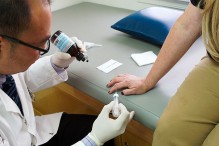Among the most common reasons clients visit Charlottesville Orthopaedic Center are problems with joints, specifically knee and hip joints. Let’s face it…we are all getting older, and these weight-bearing joints are among the first to let us know that fact loud and clear! Over time, problems such as arthritis or just general wear-and-tear can cause stiffness, discomfort, pain, and even loss of mobility.
When less-invasive treatments prove ineffective in dealing with pain and mobility loss, then it may be time to consider a joint replacement. While joint replacement surgery is more common now than it used to be, as well as much more advanced than in earlier days, it is still a step that doctors don’t take lightly. Joint replacements involve invasive surgery, and we want to make sure that it is the right option for patients suffering from knee or hip pain.
Here are the top 10 things you should know about joint replacements, if you think this surgery could be in your future.
Who Usually Needs A Joint Replacement?
Those suffering from joint damage, either from arthritis, other degenerative conditions, or injuries, who do not find relief from less invasive treatments may be candidates for joint replacement surgery. After an initial visit with an orthopaedist, the doctor will recommend care options for your particular condition, possibly including a routine of exercise, physical therapy, and prescription drugs. The doctor may also likely schedule some imaging of the joint, such as VisionScope, to see exactly what’s going on. If original treatment options don’t prove successful, and imaging shows severe enough damage, then surgery will be considered.
Joint Replacement Is Common
Many people who become candidates for joint replacement surgery may feel like they’re outliers with joints that just don’t respond the way they should. That’s not the case at all! Joint replacements are becoming more and more common, with over a million people in the U.S. alone going through the surgery every year.
Because this surgery is becoming more common, it is also improving at a rapid pace. Recovery times that were once incredibly lengthy have shortened, and there are fewer complications than in earlier days. This is not your grandmother’s joint replacement, that’s for sure!
Not All Prosthetic Joints Are The Same
The individual needs of each patient will determine what prosthetic joint will work best for their situation. For some patients, only a partial joint replacement is necessary, meaning that part of the original joint will be left in place. For other, a full replacement with a prosthetic joint will be necessary.
Prosthetic joints also come in a variety of materials, including metal, plastic, and ceramic. Doctors analyze each patient’s case before deciding what the most appropriate material will be for the replacement, making sure the joint lasts as long as possible before requiring a replacement.
You Will Likely Be Walking Sooner Than You Think
For both knee and hip replacement surgery, patients usually begin walking with the help of a walker within 24 hours of the operation. Moving around helps to speed the healing process and prevent post-surgery clots that could be dangerous. The recovery period after surgery will include exercises that will help get patients back to enjoying a normal routine as quickly as possible.
There Will Be Pain After Surgery, But It Is Manageable
Even with technological advancements, joint replacement is still a major surgery and will involve some soreness and pain after the fact. This discomfort is absolutely manageable, and your doctor will make every effort to provide the right medication to help with recovery.
Don’t Plan On A Long Hospital Stay
Most patients having a total hip or knee replacement can expect a hospital stay of only 1-3 days. Prior to surgery, there will be a discussion on limitations to mobility at home, and it is possible that a brief stay at a rehabilitation center will be recommended.
Follow Your Post-Surgery Instructions To The Letter
Post-surgery instructions are provided with very good reason – to get patients up and active as soon as possible, while trying to prevent damaging infections and other possible complication. It is so important to follow these instructions to the letter, otherwise you may end up back in the hospital sooner than you think.
Plan Ahead For Your Post-Surgery Home Life
For patients that are going directly home from surgery, it’s important to have a discussion with your doctor about what accomodations may need to be made in your home to support your recovery. For example, when you come home, you will likely be unable to climb stairs for a few weeks, which means you will require access to a bedroom and restroom on the first floor. Other considerations include requiring assistance initially getting up and down from sitting, help with household chores, and transportation to post-operative appointments.
Physical Therapy is Important For A Good Outcome
Physical therapy can offer better outcomes for patients who have undergone joint replacement surgery. While rest is important for recovery, a total lack of movement is not beneficial! A regular therapy routine can help to strengthen muscles around the joint, making it easier to get back to a normal range of motion. It can also help to identify any possible complications more quickly, leading to better prevention of additional treatment after surgery.
Artificial Joints Last Between 15-20 Years, Sometimes More
While they don’t last forever, artificial joints do have a lengthy lifespan. Most joints last somewhere between 15 and 20 years before a replacement is needed, although it is possible for their lifespan to go beyond that. It all depends on the type of material used and the wear on the prosthetic joint over time. Your doctor will recommend routine checkups to make sure everything is healing and wearing properly.
Have questions about joint replacement surgery? Then why not schedule an appointment with one of our doctors by calling (434) 244-8412.


